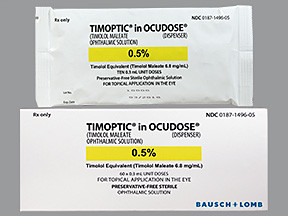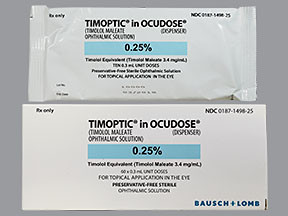TIMOLOL SOLUTION PRESERVATIVE-FREE - OPHTHALMIC
PHONETIC PRONUNCIATION: (TIE-moh-lohl)
COMMON BRAND NAME(S): Timoptic
GENERIC NAME(S): timolol maleate/PF
Uses
USES: This medication is used to treat high pressure inside the eye due to glaucoma (open angle-type) or other eye diseases (e.g., ocular hypertension). Lowering high pressure inside the eye helps to prevent blindness. This medication works by decreasing the amount of fluid within the eye. Timolol belongs to a class of drugs known as beta-blockers.
How to use TIMOLOL SOLUTION PRESERVATIVE-FREE - OPHTHALMIC
HOW TO USE: This medication is for use in the eye(s), usually one drop in the affected eye(s) once or twice a day, as directed by your doctor. To apply eye drops, wash your hands first. To avoid contamination, do not touch the dropper tip or let it touch your eye or any other surface. If you wear contact lenses, remove them before using the eye drops. Wait at least 15 minutes after using this medication before putting in your contact lenses. This product does not contain a preservative. Therefore, do not open the single-use container until just before you are ready to use it. After use, throw away the remaining contents of the container right away. Tilt your head back, look upward and pull down the lower eyelid to make a pouch. Hold the dropper directly over your eye and place one drop in your eye. Look downward and gently close your eyes for 1 to 2 minutes. Place one finger at the corner of your eye (near the nose) and apply gentle pressure. Try not to blink and do not rub your eye. This will prevent the medication from draining out. Repeat these steps for your other eye if so directed. If you are using another kind of eye medication (e.g., drops or ointments), wait at least 10 minutes before applying other medications. Use eye drops before eye ointments to allow the eye drops to enter the eye. Use this medication regularly in order to get the most benefit from it. To help you remember, use it at the same time(s) each day. It is important to continue using this medication even if you feel well. Most people with glaucoma or high pressure in the eyes do not feel sick.
Side Effects
Precautions
Interactions
Overdose
Images
Reviews
Disclaimer
IMPORTANT: HOW TO USE THIS INFORMATION: This is a summary and does NOT have all possible information about this product. This information does not assure that this product is safe, effective, or appropriate for you. This information is not individual medical advice and does not substitute for the advice of your health care professional. Always ask your health care professional for complete information about this product and your specific health needs.


No Reviews Yet